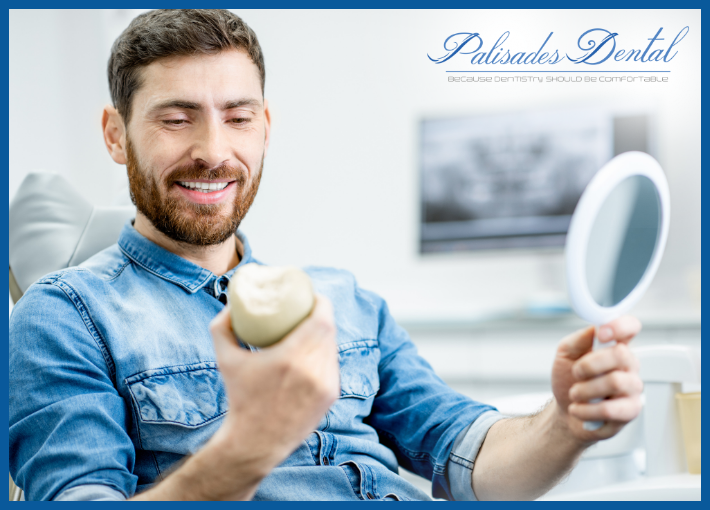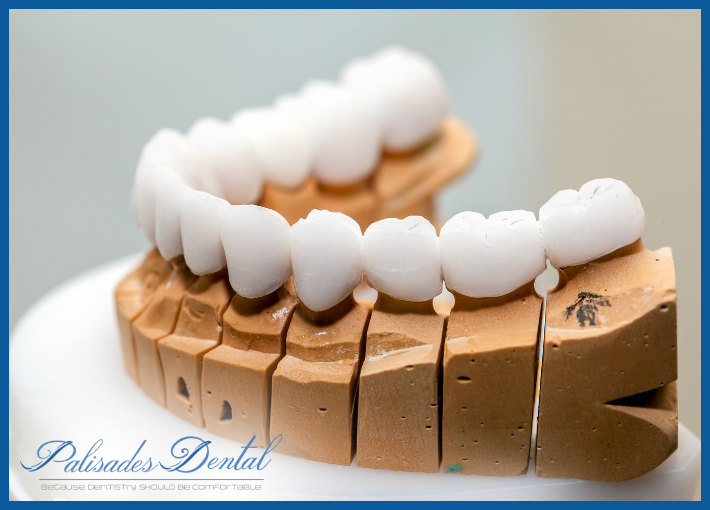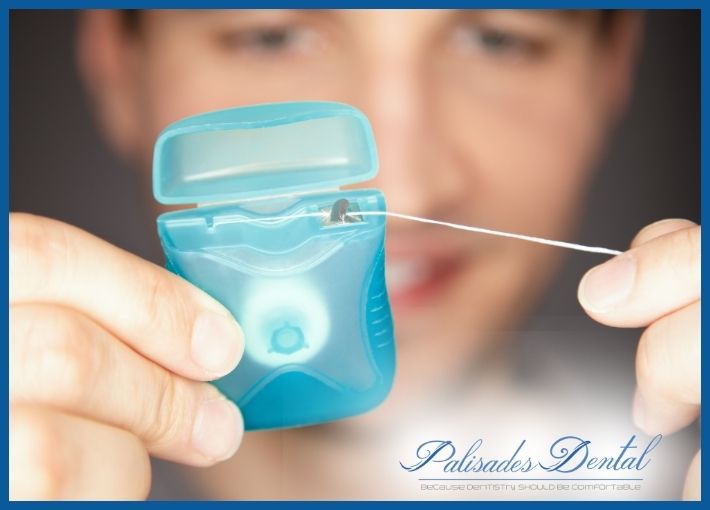Have questions about dental crowns? Your dentist at Palisades Dental can talk to you about the cost, durability, and other pros and cons to help you determine the best type of crown for your needs. Getting regular dental checkups and practicing good dental hygiene is vital for maintaining your teeth healthy. Start 2023 by getting your teeth checked! And if you have questions on any dental treatment, come and see us to get them all answered!
A dental crown is a cover for a damaged tooth. It helps restore the normal shape, function, and size of the tooth.
Crowns don’t last forever, but you can extend the life of a crown if you take the proper precautions.
In this article, we’ll take a closer look at the different types of crowns and their longevity, as well as the warning signs that a crown may need to be replaced.
What is the purpose of a crown?
According to the American Dental Association (ADA), if you have a large filling but not enough tooth remaining to hold it, a crown can help strengthen the tooth.
Your dentist may also use a crown to:
- restore a broken or cracked tooth
- protect a weak tooth from breaking
- attach dental bridges
- protect a fragile tooth following a root canal
Dental crowns can be made from a variety of materials, some of which last longer than others.
What to know about different types of crowns and their longevity
“The average lifespan of a crown is about 10 years,” says William D. Cranford, Jr., DMD, of Cranford Dental.
But when properly fabricated and cared for, he says that crowns of any material can last for decades.
When it comes to the type of crown that’s used, Cranford says your dentist will consider the strength, durability, and aesthetics of each material when deciding which crown is best suited to your particular situation.
Other factors that your dentist may consider when deciding on the best crown material for your tooth include:
- the location of the tooth
- how much of the natural tooth is still remaining
- how much of the crown will be visible when you smile
Let’s examine the four most commonly used crowns and their expected longevity.
Zirconia
Categorized as a type of ceramic crown, zirconia crowns are made from zirconium dioxide, a very strong type of material that’s related to titanium. The durability of these crowns makes them extremely resistant to fracture.
According to Cranford, zirconia is the strongest non-metallic material for crowns. However, he explains that zirconia crowns don’t always fit as well as other crowns.
A 2016 study found that monolithic zirconia crowns were the least likely to crack or split after being subjected to high bite forces.
With proper oral hygiene and care, a zirconia crown can easily last 10-15 years — or longer.
Porcelain fused to metal
Porcelain-fused-to-metal (PFM) crowns are a popular type of crown, and are also one of the most natural-looking options. This makes them well-suited for front teeth.
“Porcelain-fused-to-metal crowns were the most frequently prescribed cosmetic solution for teeth over the last 60 years” Cranford explains. “However, porcelain is prone to chipping, and with age, the metal margin or edge often shows as gums recede.”
That said, he does point out that these metal-backed restorations still find a place in dentistry, particularly for bridges that replace missing teeth.
On average, PFM crowns can be expected to last from 5-15 years. With good dental care, they may last longer.
Lithium disilicate

This material is a strong type of glass ceramic that’s made of lithium (a silver-white metal) and silicon (a hard, crystalline solid).
Dentists can use lithium disilicate to make crowns in-office with a specialized unit. This means you can get a crown made and permanently placed in just one office visit.
Cranford says that, currently, dental laboratories report this as the most prescribed crown material.
“Lithium disilicate is very strong and can be adjusted for translucency,” Cranford says. “These crowns are cosmetically appealing, fit well at margins, and bond well to teeth.”
These crowns also last at least 5-15 years — or longer — with the right care.
Gold
“Yellow gold has been the material of choice for crowns for over 100 years,” Cranford says. This is due to its strength, its resistance to chipping and cracking, and its ability to fit the tooth well.
In fact, a 2015 literature review found that gold is still the “gold standard,” with a 95 percent survival rate over 10 years. With proper care, it’s possible for a gold crown to last for decades.
A drawback to using gold, however, is its unnatural appearance. Dentists typically consider gold for molars that aren’t visible when you smile.
Dentists today often combine gold with other metals, like palladium, chromium, or nickel. This helps to keep the crown strong, but reduces its cost.
Do crowns last longer than veneers?
Depending on the material used and your dental habits, the lifespan of a veneer versus a crown is similar, but veneers may not last as long because they are thinner.
In general, a veneer is recommended for cosmetic purposes. But if you have any decay, cracks, or excessive wear, a crown will be more beneficial. Your dentist will be able to determine which restoration procedure is right for you.
How will you know when a crown needs to be replaced?
“If the existence of decay is visible, either clinically or radiographically, the crown needs to be replaced,” he says.
Reshad also says if there are any open margins where the crown isn’t seated properly on the tooth, or there’s a gap between the crown and the tooth, the crown needs to be changed.
Also, if the crown is broken or there’s space between the crown and the adjacent teeth that lets food and bacteria accumulate, it’s a sign that the crown should be replaced, Reshad explains.
Some of the warning signs that a crown may be nearing the end of its lifespan include:
- Pain involving the tooth with the crown. “Most likely, tooth decay is the culprit,” Reshad says. As a result, the crown needs to be removed along with the decay underneath, and a new crown will be made and placed, he explains.
- A feeling that the crown is unstable or appears to be moving. Reshad says this can happen when chewing something sticky, like gum, caramel, or even bread.
- The tooth with the crown is no longer aesthetically pleasing. Reshad says some patients like to have whiter crowns, especially if the adjacent teeth have been whitened. They may also wish to create a different shape or look. Also, if a crown is chipped, a patient may want to have it replaced.
What can affect the lifespan of a crown?
The lifespan of a crown can vary depending on the type of material used, as well as your dental hygiene habits and other lifestyle factors.
According to Reshad, the most important factor in the longevity of a crown is a good oral hygiene regimen. This includes:
- brushing your teeth 2 to 3 times a day
- flossing at least once a day
- getting a dental cleaning every 6 months
According to Reshad, other factors that can affect the longevity of a crown include:
- The type of crown. The quality of the crown, how well it’s made, and the material used to make it can all play a role in the longevity of the crown.
- The dentist’s skill-set. Some factors, like how well the dentist prepared the tooth, and how they took the impression or scanned the tooth, can also make a difference in the life of the crown. Using a digital scanner is more accurate than impression materials with trays for a single tooth.
- Health of the affected tooth. If the tooth was relatively healthy with longer roots and healthier surrounding gum and bone levels, both the crown and the tooth will likely have a better prognosis.
- Using your teeth as tools. Using your teeth to uncork bottles or tear threads, or to chew on ice and pencils, can negatively impact the longevity of a crown.
- Tooth grinding. Clenching and grinding your teeth, especially at night, can wear down a crown’s surface and jeopardize its stability, especially if it’s made of a ceramic material. You may want to ask your dentist about a mouthguard you can wear while you sleep.
If you are looking for the highest standard of oral care, look no further. At Palisades Dental, we make sure we provide the best treatment for you and your family. We pride ourselves in taking the time to fully understand your family’s needs and concerns — and deliver a superior service. Schedule an appointment for them today at 801-756-1009. Join our Facebook page for more tips.
Reference: [https://www.healthline.com/health/how-long-does-a-crown-last#what-affects-lifespan]









